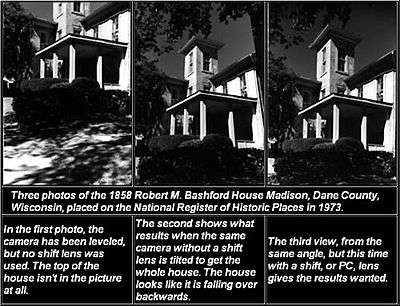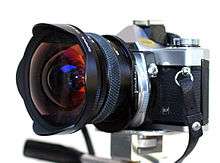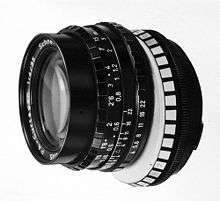Perspective control lens
 |
| (a) Keeping the camera level, with an ordinary lens, captures only the bottom portion of the building. |
 |
| (b) Tilting the camera upwards results in vertical perspective. |
 |
| (c) Shifting the lens upwards results in a picture of the entire subject. |


In photography, a perspective control lens allows the photographer to control the appearance of perspective in the image; the lens can be moved parallel to the film or sensor, providing the equivalent of corresponding view camera movements. This movement of the lens allows adjusting the position of the subject in the image area without moving the camera back; it is often used to avoid convergence of parallel lines, such as when photographing a tall building. A lens that provides only shift is called a shift lens, while those that can also tilt are called tilt-shift lenses. The terms PC and TS are also used by some manufacturers to refer to this type of lens.
Short-focus perspective-control (PC) lenses (i.e., 17 mm through 35 mm) are used mostly in architectural photography; longer focal lengths may also be used in other applications such as landscape, product, and closeup photography. PC lenses are generally designed for single-lens reflex (SLR) cameras, as rangefinder cameras do not allow the photographer to directly view the effect of the lens, and view cameras allow for perspective control using camera movements.
A PC lens has a larger image circle than is required to cover the image area (film or sensor size). Typically, the image circle is large enough, and the mechanics of the lens sufficiently limited, that the image area cannot be shifted outside of the image circle. However, many PC lenses require a small aperture setting to prevent vignetting when significant shifts are employed. PC lenses for 35 mm cameras typically offer a maximum shift of 11 mm; some newer models offer a maximum shift of 12 mm.
The mathematics involved in tilt lenses are described as the Scheimpflug principle, after an Austrian military officer who developed the technique for correcting distortion in aerial photographs.
The first PC lens manufactured for an SLR camera in any format was Nikon’s 1961 f/3.5 35 mm PC-Nikkor; it was followed by an f/2.8 35 mm PC-Nikkor (1968), an f/4 28 mm PC-Nikkor (1975), and an f/3.5 28 mm PC-Nikkor (1981).[1] In 1973, Canon introduced a lens, the TS 35 mm f/2.8 SSC,[2] with tilt as well as shift functions.
Other manufacturers, including Olympus, Pentax, Schneider Kreuznach (produced as well for Leica), and Minolta, made their own versions of PC lenses. Olympus produced 35 mm and 24 mm shift lenses. Canon currently offers 17 mm, 24 mm, 45 mm, and 90 mm tilt/shift lenses. Nikon currently offers 24 mm, 45 mm, and 85 mm PC lenses with tilt and shift capability.
Shape control
When the camera back is parallel to a planar subject (such as the front of a building), all points in the subject are at the same distance from the camera, and are recorded at the same magnification. The shape of the subject is recorded without distortion. When the image plane is not parallel to the subject, as when pointing the camera up at a tall building, parts of the subject are at varying distances from the camera; the more distant parts are recorded at lesser magnification, causing the convergence of parallel lines.[3] Because the subject is at an angle to the camera, it is also foreshortened.
When the camera back is not parallel to a planar subject, it is not possible to have the entire subject in focus without the use of tilt or swing; consequently, the image must rely on the depth of field to have the entire subject rendered acceptably sharp.
With a PC lens, the camera back can be kept parallel to the subject while the lens is moved to achieve the desired positioning of the subject in the image area. All points in the subject remain at the same distance from the camera, and the subject shape is preserved. If desired, the camera back can be rotated away from parallel to the subject, to allow some convergence of parallel lines or even to increase the convergence. Again, the position of the subject in the image area is adjusted by moving the lens.[4]
Applications

When making photographs of a building or other large structure from the ground, it is often impossible (without shift) to fit the entire building in the frame without tilting the camera upwards. The resultant perspective causes the top of the building to appear smaller than its base, which is often considered undesirable (b). The perspective effect is proportional to the lens’s angle of view.
Photographing from the ground, perspective can be eliminated by keeping the film plane parallel to the building. With ordinary lenses, this results in capturing only the bottom part of the subject (a). With a perspective control lens, however, the lens may be shifted upwards in relation to the image area, placing more of the subject within the frame (c). The ground level, the camera’s point of perspective, is shifted towards the bottom of the frame.
Another use of shifting is in taking pictures of a mirror. By moving the camera off to one side of the mirror, and shifting the lens in the opposite direction, an image of the mirror can be captured without the reflection of the camera or photographer. Shifting can similarly be used to photograph “around” an object, such as a building support in a gallery, without producing an obviously oblique view.
Available lenses
The earliest perspective control and tilt/shift lenses for 35 mm format were 35 mm focal length, which is now considered too long for many architectural photography applications. With advances in optical design, lenses of 28 mm and then 24 mm became available and were quickly adopted by photographers working in close proximity to their subjects, such as in urban settings.
The Arri motion-picture camera company offers a shift and tilt bellows system that provides movements for PL-mount lenses on motion-picture cameras.
Canon currently offers four lenses with tilt and shift functions: the TS-E 17 mm f/4, the TS-E 24 mm f/3.5L II, the TS-E 45 mm f/2.8, and the TS-E 90 mm f/2.8. On the 45 mm and 90 mm lenses, the mechanisms providing the tilt and shift functions can be rotated 90° to the left or right so that they operate horizontally, vertically, or at intermediate orientations. The lenses are supplied with the tilt and shift movements at right angles to each other; they can be modified so that the movements operate in the same direction. The 17 mm and the 24 mm version II lenses allow independent rotation of the tilt and shift movements. The 90 mm lens gives 0.29 magnification, making it usable for moderate close-up work. All four lenses provide automatic aperture control.
Hartblei makes tilt-and-shift lenses to fit various manufacturers’ camera bodies. It currently offers four Super-Rotator Tilt/Shift lenses for 35 mm bodies: the TS-PC Hartblei 35 mm f/2.8, the TS-PC Hartblei 65 mm f/3.5, the TS-PC Hartblei 80 mm f/2.8, and the TS-PC Hartblei 120 mm f/2.8. It also offers the TS-PC Hartblei 45 mm f/3.5 to fit several medium-format camera bodies. The tilt and shift movements can be independently rotated in any direction.
Hasselblad offers a tilt-and-shift adapter, the HTS 1.5, for use with the HCD 28 mm f/4, HC 35 mm f/3.5, HC 50 mm f/3.5, HC 80 mm f/2.8 and HC 100 mm f/2.2 lenses on H-System cameras. To allow infinity focus, the adapter includes optics that multiply the lens focal lengths by 1.5. Autofocus and focus confirmation are disabled when using the adapter.
In 2008, Leica introduced a 30 mm tilt-and-shift lens for its new S-System of digital SLRs.
Minolta offered the 35mm f/2.8 Shift CA lens for its manual focus SR-mount cameras in the 1970s and 1980s. The lens was unique among perspective control lenses in that, rather than offering a combination of tilt-and-shift, Minolta designed the lens with variable field curvature, which could make the field of focus either convex or concave (essentially a three-dimensional, spherical form of tilt).[5][6]


Nikon currently offers three PC lenses, all of which feature tilt and shift functions: PC-E Nikkor 24 mm f/3.5D ED, PC-E Micro-Nikkor 45 mm f/2.8D ED, and PC-E Micro Nikkor 85 mm f/2.8D ED. The 45 mm and 85 mm “Micro” lenses offer close focus (0.5 magnification) for macrophotography. The PC-E lenses offer automatic aperture control with the Nikon D3, D300, and D700 cameras. With some earlier camera models, a PC-E lens operates like a regular Nikon PC (non-E) lens, with preset aperture control by means of a pushbutton; with other earlier models, no aperture control is provided, and the lens is not usable.[7]
The mechanisms providing the tilt and shift functions can be rotated 90° to the left or right so that they operate horizontally, vertically, or at intermediate orientations. The lenses are supplied with the tilt and shift movements at right angles to each other; they can be modified so that the movements operate in the same direction.
In Pentax high-end DSLRs (K-7, K-5, K-5 II, K-5 IIs and K-30) the shake reduction hardware unit can be manually adjusted in the X/Y direction to achieve a shift effect with any lens using the Composition Adjust function in the menu system.[8] Although available for any lens that fits the camera body, this adjustment can not fully replace regular shift lenses as those may provide a larger shift movement.
Schneider-Kreuznach offers the PC-Super Angulon 28 mm f/2.8 lens that provides shift movements, with preset aperture control. The lens is available with mounts to fit cameras by various manufacturers, and also with 42 mm screw mount.
The Sinar arTec camera offers tilt and shift with the full range of Sinaron digital lenses.
All perspective control and tilt/shift lenses are manual-focus prime lenses; most are quite expensive compared to regular prime lenses. Some medium format camera makers, such as Mamiya, have addressed this problem by offering shift adapters that work with the maker’s other prime lenses.
In 2013, Samyang Optics introduced one of the cheapest today Tilt-Shift lenses, the Samyang T-S 24mm f/3.5 ED AS UMC, which can Tilt up to 8.5 degrees and Shift up to 12mm of axis.[9]
ARAX introduced a 35 mm f/2.8 and an 80 mm f/2.8 tilt shift lens, which are available for several camera mounts. Both lenses retail for less than the Samyang T-S 24mm. ARAX also produces a 50 mm f/2.8 tilt shift lens for Micro 4/3 and Sony NEX mounts.[10]
Aperture control
Most SLR cameras provide automatic aperture control, which allows viewing and metering at the lens’s maximum aperture, stops the lens down to the working aperture during exposure, and returns the lens to maximum aperture after exposure. For perspective-control and tilt/shift lenses, the mechanical linkage is impractical, and automatic aperture control was not offered on the first such lenses. Many PC and TS lenses incorporated a feature known as a “preset” aperture, which lets the photographer set the lens to working aperture, and then quickly switch between working aperture and full aperture without looking at the aperture control. Though slightly easier than stopped-down metering, operation is less convenient than automatic operation.
When Canon introduced its EOS line of cameras in 1987, the EF lenses incorporated electromagnetic diaphragms, eliminating the need for a mechanical linkage between the camera and the diaphragm. Because of this, the Canon TS-E tilt/shift lenses include automatic aperture control.
In 2008, Nikon introduced its PC-E perspective-control lenses with electromagnetic diaphragms. Automatic aperture control is provided with the D300, D3, D700, and D4 cameras. With some earlier cameras, the lenses offer preset aperture control by means of a pushbutton that controls the electromagnetic diaphragm; with other earlier cameras, no aperture control is provided, and the lenses are not usable.
Perspective control in software
Computer software (such as Photoshop's perspective and distort functions) can be used to control perspective effects in post-production. However, this technique does not allow the recovery of lost resolution in the more distant areas of the subject, or the recovery of lost depth of field due to the angle of the film/sensor plane to the subject. Areas of the image enlarged by these digital techniques may suffer from the visual effects of pixel interpolation, depending on the original image resolution, degree of manipulation, print/display size, and viewing distance.
The effect of using tilt or swing movements is less easily accomplished in post-production. If every part of the image is within the depth of field, it is fairly easy to simulate the effect of shallow depth of field that could be achieved by using tilt or swing;[11] however, if the image has a finite depth of field, post-production cannot simulate the sharpness that could be achieved by using tilt or swing to maximize the region of sharpness.
Gallery of perspective control lenses
-

Olympus 24 mm f/3.5 Zuiko-Shift. 10 mm maximum shift. Mounted on an Olympus camera.
-

35 mm f/2.8 PC-Nikkor. 11 mm maximum shift.
-

Arax 35 mm f/2.8 TS mounted on a Canon EOS 40D. Fully tilted.
-

Canon TS-E 24 mm f/3.5L. 11 mm maximum shift. 8° maximum tilt.
-

Minolta 35 mm f/2.8 shift. 11 mm maximum shift.
-

Pentax Shift 28 mm f/2.8 SMC lens.
-

Pentax Shift 6x7 75 mm f/4.5. 20 mm maximum shift. Mounted on a Pentax 6×7 medium-format SLR.
-

Pentax-mount Arax 35 mm f/2.8 TS at max tilt and no shift.
-

Samyang T-S 24 mm f/3.5 mounted on Sony A77 at max tilt and no shift.
See also
- Canon TS-E 24mm lens
- PC-E Nikkor 24mm f/3.5D ED Lens
- Lensbaby, another type of movable lens
- View camera, a camera type that allows tilt and/or shift control.
References
- Ray, Sidney F. 2000. The geometry of image formation. In The Manual of Photography: Photographic and Digital Imaging, 9th ed. Ed. Ralph E. Jacobson, Sidney F. Ray, Geoffrey G. Atteridge, and Norman R. Axford. Oxford: Focal Press. ISBN 0-240-51574-9
- ↑ "Tale Seventeen : PC-Nikkor 28 mm f/4". Nikon Corporation.
- ↑ Canon TS 35 mm f/2.8 SSC lens. Canon Camera Museum
- ↑ Ray 2000, 171.
- ↑ Ray 2000, 172.
- ↑
- ↑
- ↑ PC-E Nikkor 24 mm f/3.5D ED User's Manual , 7MAA49C2-02, p. 21. Nikon Corporation.
- ↑ "Pentax K-5 User's Manual", p. 220, Pentax Ricoh Imaging Corporation.
- ↑ "Samyang T-S 24mm f/3.5 ED AS UMC Lens Review". Retrieved November 23, 2013.
- ↑ araxfoto.com
- ↑ Held, R. T.; Cooper, E. A.; O'Brien, J. F.; Banks, M. S. (March 2010). "Using blur to affect perceived distance and size" (PDF). ACM Transactions on Graphics 29 (2): 19:11–19:11. doi:10.1145/1731047.1731057. ISSN 0730-0301. Retrieved 2012-02-23.
External links
- What is perspective correction?
- How Shift Lenses Change your Life
- History of the PC-Nikkor lens
- Instruction manual for 35 mm PC-Nikkor lens
- Perspective Control (Shift Lenses) in Architectural Photography
- Perspective Control (Tilt/Shift range) Architectural View Camera
- Using the 35 mm Perspective Control Lens
- Dictionary of Film and Photography: Perspective control (PC) lens
- Using a perspective control lens (shift lens)
- Tutorial: Perspective Control Lenses
- Tilt-Shift lens selection and difference
- Perspective Correction Using Software
- Page of Links to Galleries and Information on Tilt-Shift Photography and Lenses
- Sinar arTec camera with tilt and shift
- Rokinon 24 mm shift lens

